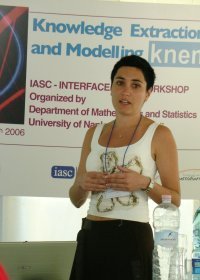Systems Seminar - ECE
Partial Least Squares Methods: from regularized regression to structural equation models
Add to Google Calendar

The acronym PLS (Partial Least Squares) (PLS) refers to a family of "soft modelling" methods implemented by various extensions of the Nonlinear estimation by Iterative Partial Least Squares (NIPALS) algorithm. The basic principles of NIPALS were first developed in order to model the relationships between several blocks of observed variables, each one supposed to be the expression of an underlying latent variable (PLS approach to Structural Equation Models, or PLS Path modeling "“ PLS-PM). Then, NIPALS iteration was exploited to implement a component-based regularized regression technique, known as PLS regression (PLS-R).
This talk will focus on the computational and methodological aspects of these two methods.
Laura Trinchera obtained her Master degree in Economics at the University of Naples "Federico II" in 2004, and received her Doctoral degree in Statistics at the Department of Mathematics and Statistics of the University of Naples "Federico II" (Italy) in February 2008. From November, 2008 to November, 2009 she was a postdoctoral fellow at the Department of Development Studies of the University of Macerata (Italy). From January, 2010 to August, 2011 she was a postdoctoral fellow at the Department of Signal Processing & Electronic Systems of the SUPELEC (France). From September 2011 she is Assistent Professor at AgroParisTech.
She is member of the ISBIS (International Society for Business and Industrial Statistics) section of the ISI (International Statistics Institute), of the Societé Francaise de Statistique (SFdS), and of the CLAssification and Data Analysis Group (CLADAG) of the Italian Statistical Society. She serves as a reviewer for several scientific journals, among which the Journal of Applied Statistics (Routledge Taylor and Francio Group) and Computational Statistics (Springer).
Her research interests cover: traditional multivariate analyses, Structural Equation Models (SEM) and the several estimation techniques proposed for SEM, paying special attention to the PLS Path Modeling algorithm, the issue of Unobserved Heterogeneity in SEM, the use of non-linear relations both in PLS Regression and in PLS Path Modeling. More recently it is paying attention to variable selection in regression models, when a huge amount of variables are available.
 MENU
MENU 
